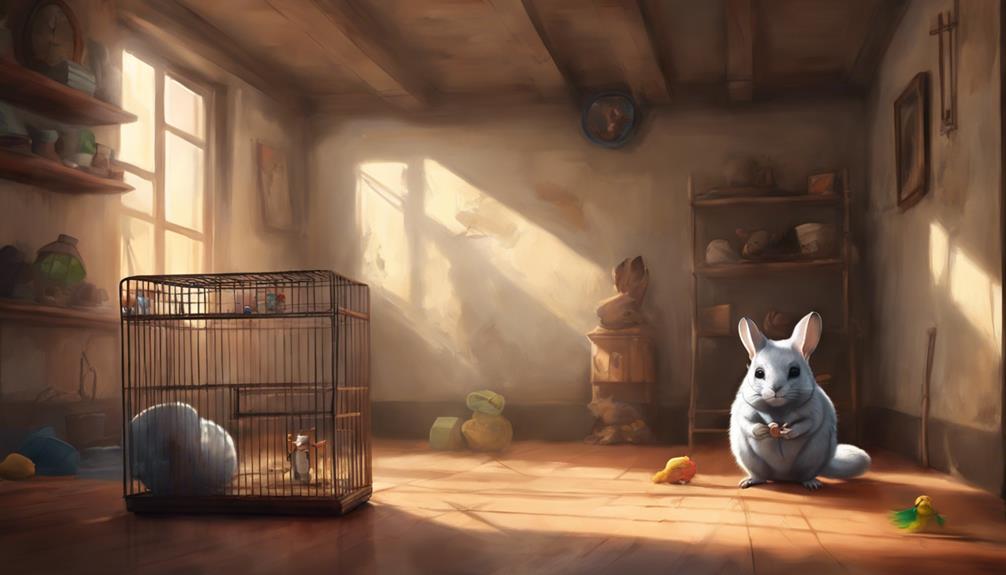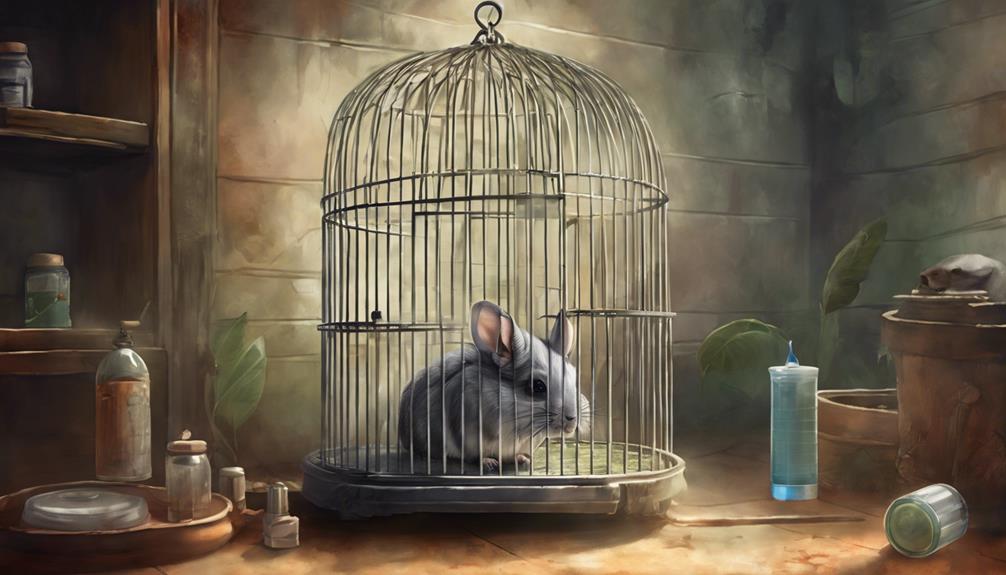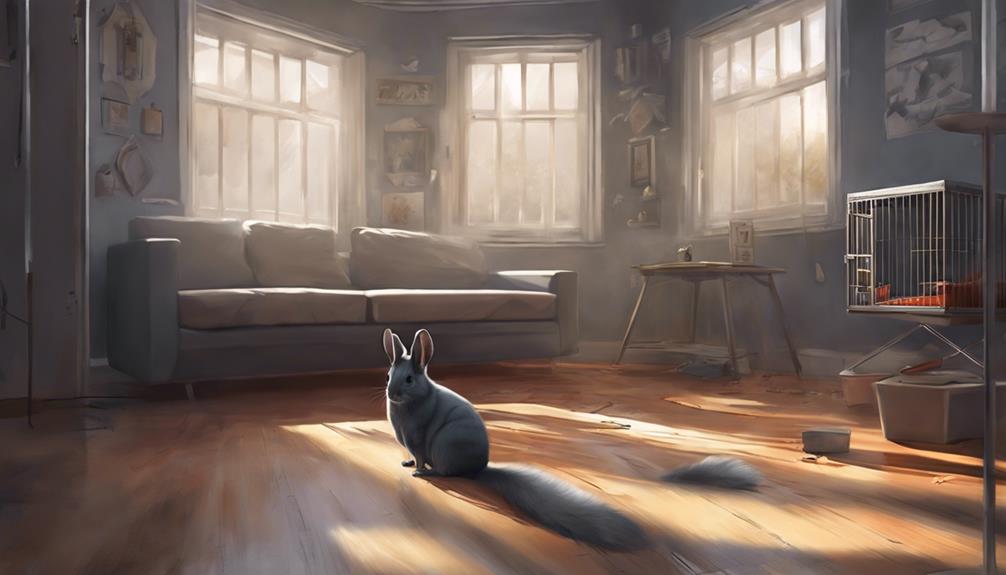How to Choose the Right Location for Your Chinchilla's Cage

When it comes to selecting the ideal location for your chinchilla's cage, there are a few key factors to consider. Firstly, it's important to place the cage in a quiet area of your home. Chinchillas are sensitive to loud noises and sudden movements, so a peaceful environment will help keep them calm and stress-free. Additionally, chinchillas are sensitive to temperature extremes, so it's crucial to avoid placing their cage near drafty windows or in direct sunlight.
Another essential consideration is the level of natural light in the chosen location. While chinchillas need some exposure to natural light for their well-being, direct sunlight can cause overheating. Therefore, finding a spot with indirect natural light is ideal. Finally, it's essential to place the cage in an area where you can easily monitor your chinchilla's behavior and interact with them regularly. This will help strengthen your bond with your pet and ensure their overall health and happiness.
Key Takeaways
- Place the cage in a quiet area to avoid stress-inducing noises and sudden movements.
- Ensure proper ventilation to prevent respiratory issues and mold growth.
- Regulate temperature for comfort and health, avoiding extremes to prevent illnesses.
- Shield the cage from drafts and direct sunlight to maintain a balanced environment for your chinchilla.
Importance of Proper Ventilation
Ensuring adequate ventilation in your chinchilla's cage is essential for maintaining their health and well-being. Proper airflow management offers a myriad of benefits for these small, furry creatures.
Good ventilation helps prevent the buildup of harmful ammonia from urine, which can lead to respiratory issues in chinchillas. It also aids in regulating humidity levels, reducing the risk of mold growth and respiratory infections.
Temperature Considerations
Properly regulating the temperature in your chinchilla's cage is important for their comfort and health. Chinchillas are sensitive to high temperatures and can easily suffer from heat stroke, so ensuring a cool environment is essential. On the other hand, they also dislike extreme cold, which can lead to health issues like respiratory infections. Finding the right balance is key to keeping your furry friend happy and healthy.
Here are some temperature control strategies and climate control tips to help you maintain an ideal environment for your chinchilla:
| Heating options | Cooling solutions |
|---|---|
| Ceramic heat emitters | Providing a granite or marble slab for them to lay on |
| Snuggle Safe heat pads | Keeping the cage in a well-ventilated area |
| Infrared heat lamps | Using a small fan to circulate air |
Minimizing Noise Disturbances
Minimizing noise disturbances is crucial for creating a peaceful environment for your chinchilla to thrive in. When selecting the location for your chinchilla's cage, noise control should be a top priority. Chinchillas are sensitive animals that can easily get stressed by loud noises, so it's important to choose a quiet spot in your home. Avoid placing the cage near sources of constant loud sounds like televisions, stereos, or busy areas where people frequently pass by.
Consider placing the cage in a calm room away from high-traffic areas to provide your chinchilla with a serene atmosphere. Bedrooms or home offices can be good choices as they typically have lower noise levels compared to living rooms or kitchens. By strategically positioning the cage in a quiet location, you can help your chinchilla feel safe and secure in its environment, promoting overall well-being and happiness.
Avoiding Drafts and Direct Sunlight
When setting up a chinchilla cage, it's important to shield these sensitive creatures from drafts and direct sunlight. Drafts can cause chinchillas to develop respiratory issues, while direct sunlight can lead to overheating and discomfort.
Draft Protection Tips
To keep your chinchilla safe and comfortable, make sure their cage is placed away from direct sunlight and drafts. Here are some draft protection tips to make certain your furry friend stays cozy and healthy:
- Window Screening: Use window screening to block any drafts that may enter the room where your chinchilla's cage is located.
- Insulation Options: Consider using insulation materials around the cage to further safeguard your chinchilla from cold drafts.
- Strategic Placement: Position the cage away from windows, doors, or vents to minimize the chances of drafts reaching your chinchilla.
Sunlight Exposure Considerations
Consider carefully the placement of your chinchilla's cage to make certain it receives adequate sunlight without exposing your pet to direct sunlight or drafts. Natural lighting is essential for your chinchilla's well-being, but direct sunlight can cause overheating and discomfort.
When deciding on the location, take into account the position of windows in the room. Make sure that the cage isn't in direct line with strong sunlight that can be harsh on your chinchilla's sensitive eyes and skin.
Additionally, avoid placing the cage near drafty windows that can lead to temperature fluctuations and pose a risk to your pet's health. Finding the right balance of natural light without direct exposure is key to creating a comfortable environment for your furry friend.
Assessing Humidity Levels

Surveying the atmospheric moisture content is essential when selecting the ideal location for your chinchilla's cage. High humidity levels can pose risks to your chinchilla's health and comfort, making it critical to assess and control the humidity in their living environment.
Here are three key points to contemplate:
- Humidity Control: Chinchillas thrive in low humidity environments, ideally between 40-60%. Excessive moisture in the air can lead to respiratory issues and fur matting. Make sure the chosen location allows for easy humidity regulation to maintain ideal levels for your pet.
- Bedding Options: The type of bedding used in the cage can impact humidity levels. Choosing bedding materials that absorb moisture effectively can help in controlling humidity. Opt for bedding options like aspen shavings or paper-based bedding to assist in maintaining a dry and comfortable habitat for your chinchilla.
- Ventilation: Good airflow is vital in preventing humidity buildup. Select a location with adequate ventilation to promote air circulation and prevent stagnant, humid conditions within the cage. Proper ventilation aids in maintaining a healthy environment for your chinchilla to thrive.
Ensuring Adequate Space for Movement
Position your chinchilla's cage in a way that allows ample space for movement and exploration. Chinchillas are active animals that require regular exercise to stay healthy and happy. When setting up the cage, consider the exercise options and playtime activities your chinchilla will engage in.
Make sure that the cage layout includes room for your chinchilla to run, jump, and play. Incorporating enrichment items such as tunnels, platforms, and chew toys can encourage physical activity and mental stimulation. It's important to create a space that promotes natural behaviors and allows your chinchilla to express its playful nature freely.
Safety Precautions and Accessibility

When setting up your chinchilla's cage, prioritizing safety measures and ensuring accessibility is pivotal to creating a secure and convenient environment for your furry friend. Here are three essential tips to consider:
- Regular Cleaning Routine: Establishing a consistent cleaning schedule is vital for maintaining a hygienic living space for your chinchilla. A clean environment helps prevent health issues and guarantees your pet's well-being.
- Proper Cage Placement: Select a location that's away from direct sunlight, drafts, and other pets that may cause stress to your chinchilla. Placing the cage in a quiet area can help your pet feel secure and comfortable.
- Accessibility for Interaction: Position the cage at a height that allows you to interact with your chinchilla comfortably. This accessibility makes bonding with your pet easier and enhances the overall well-being of your furry companion.
Frequently Asked Questions
Can the Cage Be Placed Near Other Pets or Animals in the Household?
When introducing a chinchilla to other pets, it's important to supervise interactions and make sure the chinchilla's cage is secure. Placing the cage near windows can expose the chinchilla to temperature fluctuations and direct sunlight, potentially causing stress or health issues.
How Often Should the Location of the Chinchilla's Cage Be Changed for Stimulation?
To keep a chinchilla engaged, rotating their cage location can provide mental stimulation. Incorporating enrichment activities and social interaction with caregivers is vital. Changing the environment occasionally secures the chinchilla's curiosity and overall well-being.
Are There Any Specific Recommendations for Placing the Cage in a Multi-Level Home?
In a multi-level home, it's wise to contemplate cage elevation for accessibility and ventilation. Lighting is important for your chinchilla's well-being on each level. Ensuring easy access and a well-lit, airy space is key.
What Should Be Considered When Placing the Cage in a Room With High Foot Traffic?
When placing the cage in a room with high foot traffic, it's crucial to contemplate the noise level and distractions for the chinchilla's comfort. Safety and accessibility should also be prioritized to guarantee a stress-free environment.
Are There Any Tips for Incorporating the Chinchilla's Cage Into the Overall Home Decor?
Blending in the chinchilla's cage with home decor can be an artful endeavor. One must consider color schemes, textures, and placement to create harmony. Strategically placing plants or cozy blankets can enhance the overall aesthetic.











